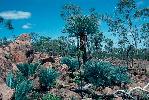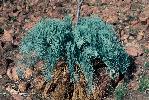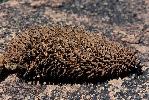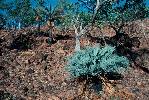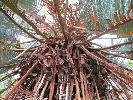Species profile—Cycas cairnsiana
Classification
Plantae (plants) → Equisetopsida (land plants) → Cycadaceae → Cycas cairnsiana
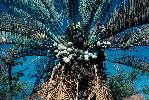
Go to Photo gallery
Species details
- Kingdom
- Plantae (plants)
- Class
- Equisetopsida (land plants)
- Family
- Cycadaceae
- Scientific name
- Cycas cairnsiana F.Muell.
- WildNet taxon ID
- 12077
- Alternate name(s)
- zamia palm
- Nature Conservation Act 1992 (NCA) status
- Vulnerable
- Environment Protection and Biodiversity Conservation Act 1999 (EPBC) status
- Vulnerable
- Conservation significant
- Yes
- Confidential
- Yes
- Endemicity
- Native
- Pest status
- Nil
- Description
- Cycas cairnsiana is a cycad with trunk 2-5m tall, 12-16 cm diameter, and covered in brownish wool. In the early stages of leaf development, the leaves are linear, soft and 3-5cm long. The mature leaves are 60-110cm long and strongly keeled (V-shaped) in cross-section, with 180-280 leaflets inserted at 20-60 degrees along the rhachis (central leaf stalk). The foliage is dull, very strongly waxy and greyish-blue. The petioles (leaf stalks) are 18-27cm long and have spines (pinnacanths) for 30-100 percent of their length. The median leaflets are 8-20cm long, 2-3.5mm wide, narrowed to 2-3mm at the base, with margins strongly recuved (curved under). The leaflets are arranged 5-6mm apart.
The male pollen cones are ovoid (egg-shaped), 16-20cm long, 7-10cm in diameter and orange. The scales arranged around the male cone are 35-50mm long, 12-15mm wide and have a spine 6-9mm long at the tip. The female sporophylls (megasporophylls) are 16-21cm long and densely covered with a powdery bloom. The apical lobe is lance-shaped, 40-70mm long, 15-25mm wide and with an apical spine 15-20mm long; each megasporophyll has 2-4 ovules. The megasporophylls are obscurely or regularly toothed with 26-32 lateral spines up to 1mm long and 1mm wide. The seeds are 36-42mm long and 30-37mm wide, bluish-white from the dense covering of powdery bloom, becoming yellowish when ripe.
This species is distinguished by the stiff, hairless, strongly waxy, pale blue mature fronds, the very narrow leaflets with strongly recurved margins, and the powdery blue to white seeds. (Hill 1998; DEWHA 2008) - Map
- View Map
- Habitat
- Cycas cairnsiana grows in shallow to skeletal gritty soils over siliceous granites. The plants occur in exposed situations among grass and sparse low shrubs. (Hill 1998; DEWHA 2008)
- Reproduction
- Male cones shed pollen and female sporophylls are receptive in November. Pollination is thought to be effected by small beetles in an obligate mutualistic relationship.
- Predators
- All foliage, reproductive parts and seeds are toxic to humans and many other mammals (Everist 1974).
- Management documents
- Conservation and management of protected plants in trade in Queensland 1995-1998. Department of Environment.
- Notes
- Contributors: Ailsa Holland, Paul Forster, Mellisa Mayhew 17/06/2009
- References
- Department of the Environment, Water, Heritage and the Arts (2008). Cycas cairnsiana in Species Profile and Threats Database, Department of the Environment, Water, Heritage and the Arts, Canberra. Accessed 05/12/2008. http://www.environment.gov.au/cgi-bin/sprat/public/sprat.pl
Everist, S. (1974). Poisonous Plants of Australia. Angus and Robertson Publishers Pty Ltd. Sydney.
Herbrecs (2008). Cycas cairnsiana, in BriMapper version 3.2.1. Queensland Herbarium. Accessed 16/12/2008.
Hill, K. (1992). A preliminary account of Cycas (Cycadaceae) in Queensland. Telopea 5(1): 177-206.
Hill, K.D. in McCarthy, P.M. (Ed) (1998). Flora of Australia 48: 612-613.
Jones, D.L. (2002). Cycads of the World, Ancient Plants in Today's Landscape. edn 2. New Holland Publishers, Australia. - Profile author
- Ailsa Holland (17/06/2009)
Other resources
- Species Profile and Threats Database (SPRAT)
- The Australasian Virtual Herbarium (AVH)
- Atlas of Living Australia
Data source
This profile data is sourced from the QLD Wildlife Data API using the Get species by ID function used under CC-By 4.0.
https://apps.des.qld.gov.au/species/?op=getspeciesbyid&taxonid=12077.
This information is sourced from the WildNet database managed by the Queensland Department of Environment and Science.


